Rennie Scaysbrook | October 19, 2018
Racer Test | Jeremy’s Toy Store
Long-time racer Jeremy Toye has fired up a new company designed to get new racers on track with Kawasaki’s brilliant little Ninja 400, and he gave us a chance to thrash one at Sonoma’s AFM round.
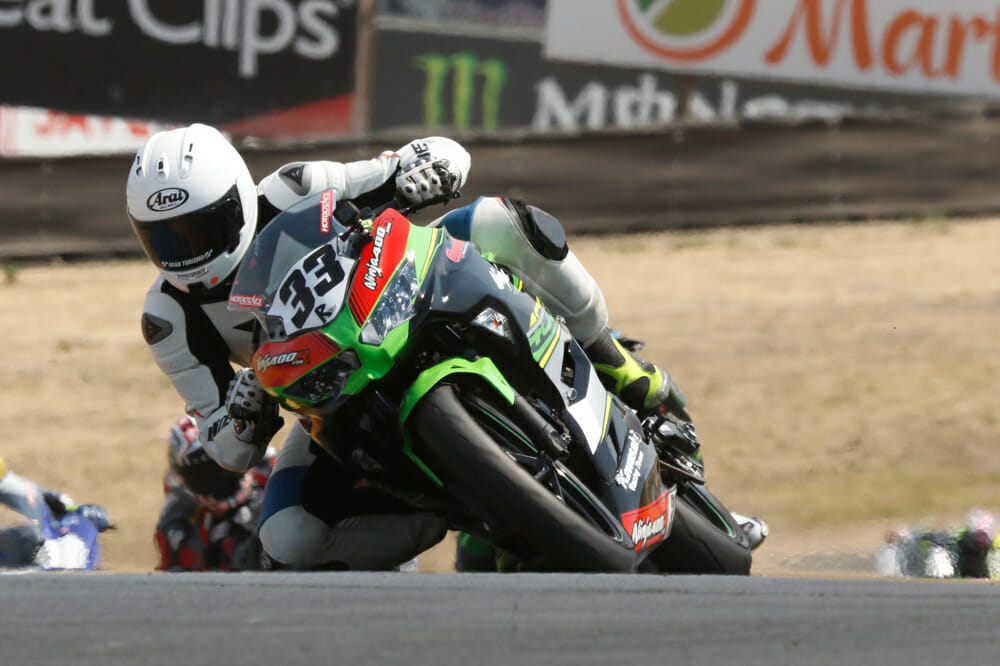 Over the rise at 3A and Toye’s toy is on rails. What a rad little bike.
Over the rise at 3A and Toye’s toy is on rails. What a rad little bike.
You can see the man’s eyes light up when he talks about this little bike. These are the eyes that have peered through the dashes of factory superbikes across the world; up the narrow Armco valleys of Macau and bottomed out over Bray Hill at the Isle of Man.
But this bike is not one of those unobtainable, rare-as-rocking-horse poo racers. It’s a Kawasaki Ninja 400. And it represents a new direction for venerable Southern Californian racer Jeremy Toye with his most recent business venture, www.ninja400r.com.
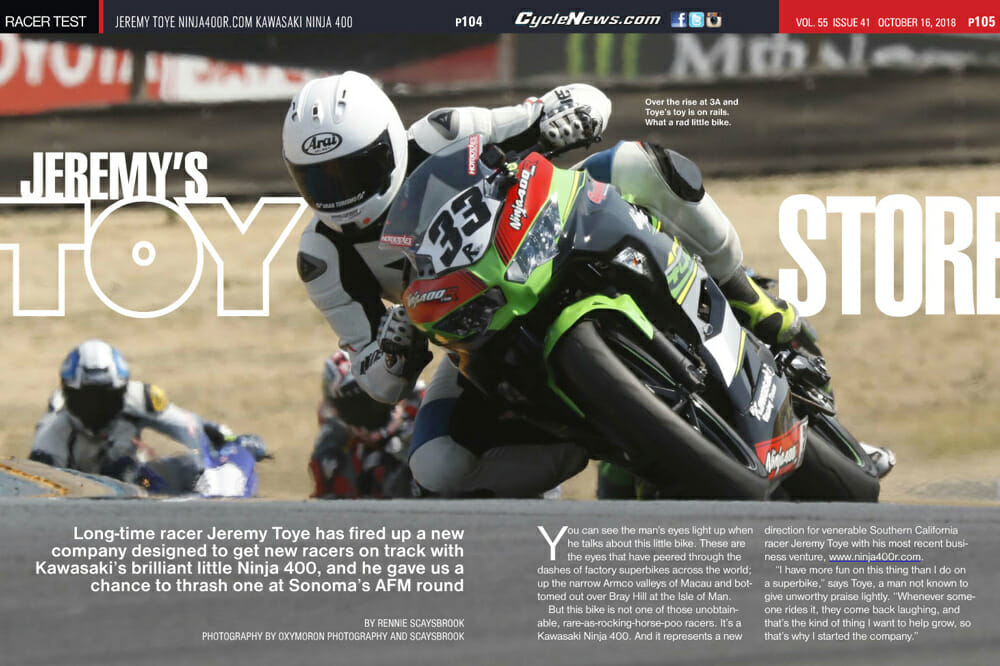
Photography by Oxymoron Photography and Scaysbrook
“I have more fun on this thing than I do on a superbike,” says Toye, a man not known to give unworthy praise lightly. “Whenever someone rides it, they come back laughing, and that’s the kind of thing I want to help grow, so that’s why I started the company.”
The company Toye speaks of is designed purely on getting more bums on racing seats across America by essentially becoming a one-stop race shop for Kawasaki’s Ninja 400. He’s only had the business up and running for under a year, but in that time he’s already seen club and national racing success with his main protagonist, Ashton Yates, finishing fourth in the 2018 MotoAmerica Junior Cup with race wins at Laguna Seca (the round Jeremy started working with Ashton) and Sonoma.
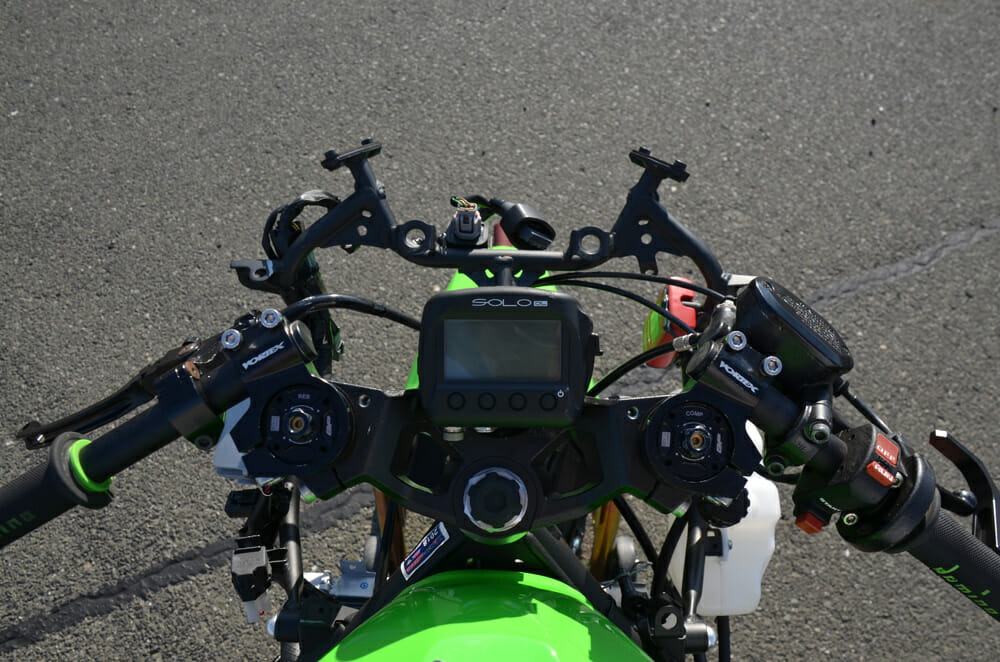 The cockpit of the Expert Club-spec Ninja400r.com racer.
The cockpit of the Expert Club-spec Ninja400r.com racer.
Toye specializes in three different versions of the Ninja 400—a base track-day machine for $8895 that will be good for any punter to get out there and circulate the racetrack, an Expert Club spec (the one we raced at Sonoma) for $11,520, and the MotoAmerica/FIM Cup spec Ninja 400 that Yates rode in the final half of the 2018 season for $12,779.
“Entry level one is the absolute basic for what it takes to get on the track safely and get around, which is very few parts,” Toye says. “The Expert Club level has the least restrictions because of the rules specific to each club. The weight is the lightest out of the three bikes and it will make the most horsepower out of the three bikes to fit the rule package.
“Then the third bike is the MotoAmerica spec, which is weight and RPM restricted and has the certain little necessities that the pro race level needs, all of which are adjustable to riders’ needs and necessities. We have a couple different suspension suppliers in GP suspension, Öhlins, K-Tech and Penske, to use for different preferences and budgets.”
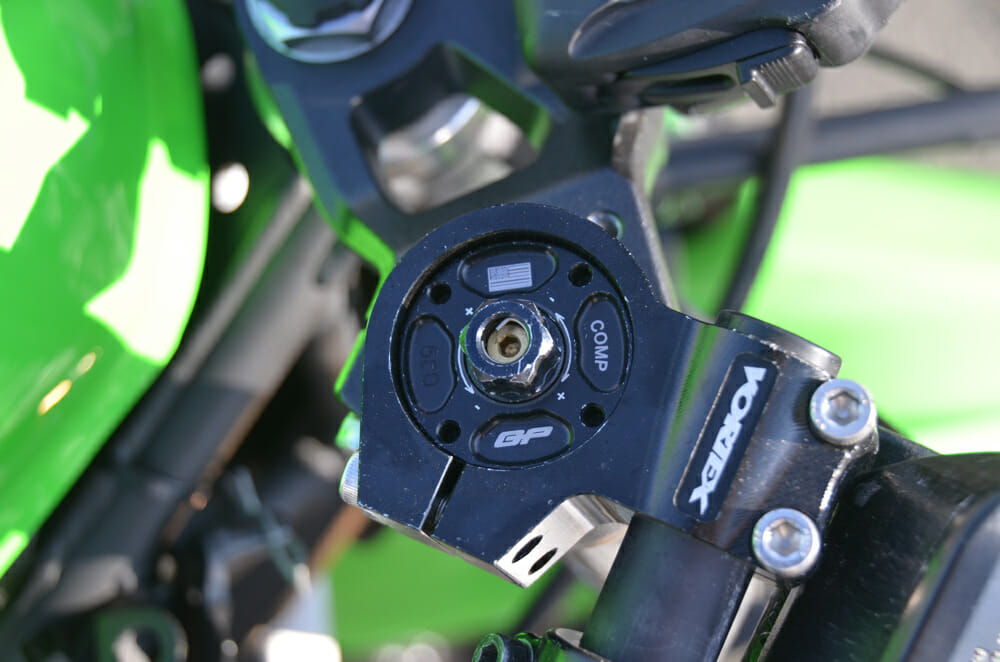 Toye prefers to use GP Suspension for the Expert Club kit, although you can opt for Öhlins or K-Tech if you want.
Toye prefers to use GP Suspension for the Expert Club kit, although you can opt for Öhlins or K-Tech if you want.
A few months ago we visited the Sonoma MotoAmerica round to do a story on the *evolving rules in the Junior Cup Championship, and it was interesting to note that, unlike the Yamaha YZF-R3, the Ninja 400 needed to be slowed down rather than made faster in the name of parity. Such a scenario does not exist in AFM Racing, so Jeremy threw us the keys to the Expert Club spec Ninja 400 to go up against fast little groms like Yamaha’s MotoAmerica’s Marc Edwards at Sonoma.
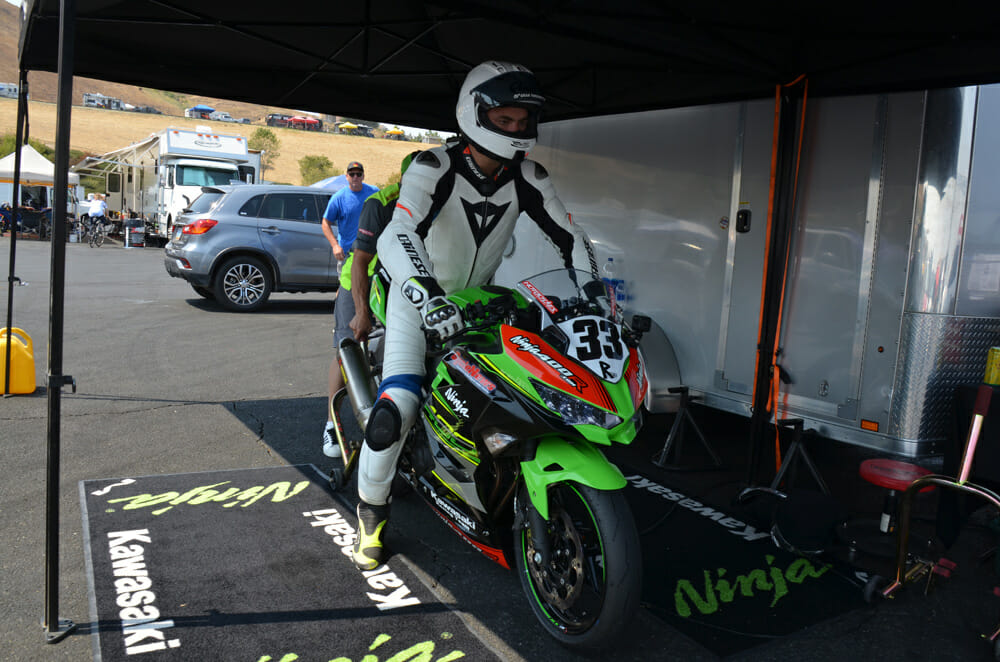 Time to go into battle with some kids!
Time to go into battle with some kids!
“Technically this bike races in all superbike roles in AFM,” says Toye. “The bike could ultimately be anywhere from 10-20 grand if you wanted something ludicrous—we’re all about ludicrous and can definitely do that!
“I think the main thing to get across here is this bike is capable of all of those levels. It’s such a good package straight out of the box. It’s a great bike for its price point throw a couple of these parts at it and it becomes even more safe and way more fun.”
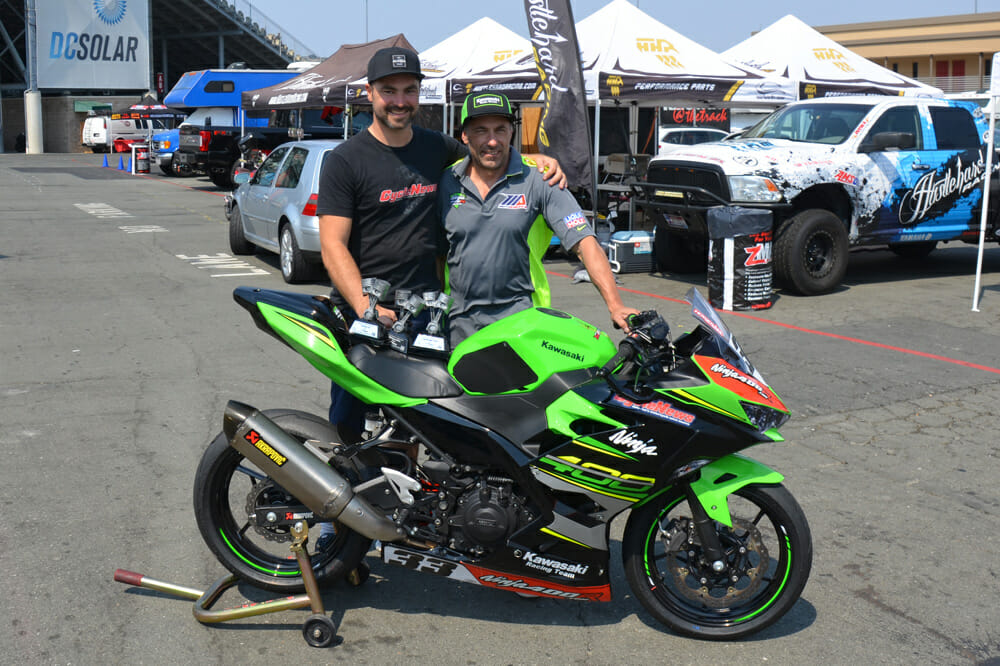 Winners and grinners! Two wins and a second place was a good day’s effort for Rennie and Jeremy.
Winners and grinners! Two wins and a second place was a good day’s effort for Rennie and Jeremy.
Building Your Expert Club Racer
So, you want to go racing, huh? This is probably the best way to do it, simply because you A) get a good base bike and B) have it assembled by a guy who really knows what he’s doing.
If you’ve ever gone racing before you’ll know the effort it takes to get a stock-standard street bike into race trim. It’s hours and hours of work, especially when you start getting into electronics and actual tuning of the motorcycle. Toye’s package does all that for you.
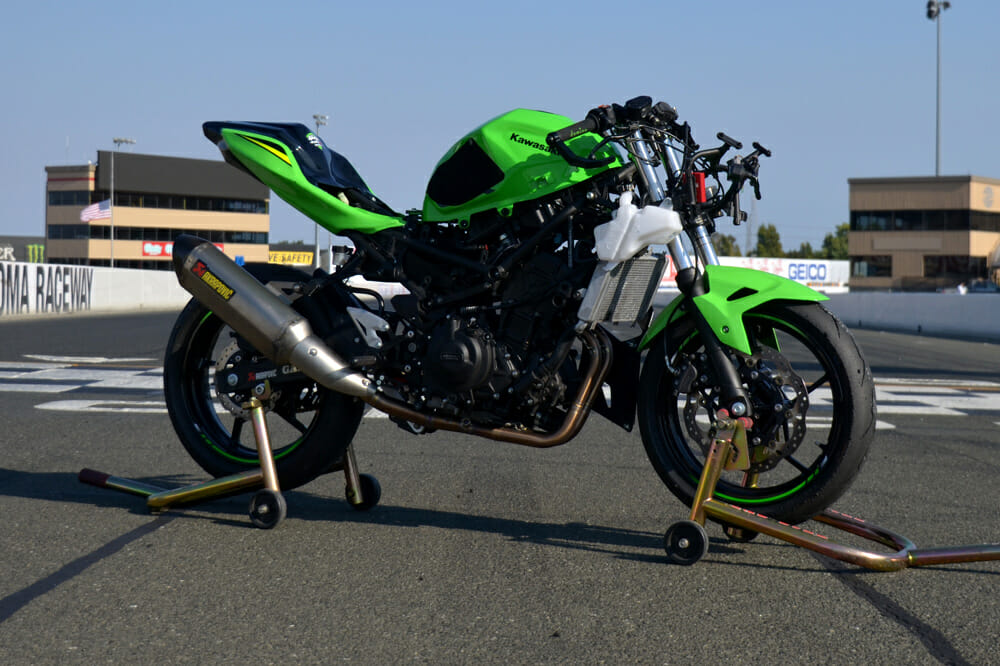
“In this configuration, you could pretty much run it as long as the stock engine would last, because really all we’ve done is polish the edges and make the tolerances proper, and it’s all the stock Kawasaki parts,” Toye says. “This could be given to a club guy that’s just going to change his oil and change his air filter, and it would be happy with that.”
Clutch
“The clutch is a little bit under evolving,” says Toye. “The clutches on these things are very small and will only stand up to probably, I’d say, 10 to 12 good launches and then they need to be replaced. We’ve been modifying our clutches to last a little bit longer and that’s a labor side of things.”
Gearbox
“The transmission has been super-teched, says Toye. “Basically, it’s a procedure that cleans up and hardens and micro-polishes the transmission to make is smoother, slicker and ultimately last longer. The tranny was a question when these bikes first came out. We’ve seen that the tranny is holding together absolutely no problem. We did that just for our own information. We’ve also got Vortex sprockets on there. The 415-kit is a tiny little jewelry chain, which I wouldn’t recommend for most track day guys, but for anybody needing some definitely weight reduction and friction reduction, that’s the way to go.”
Engine
“We reshaped some of the ports in the cylinder head,” Toye says. “The cam timing has been adjusted, and the compression level has been raised. This bike’s (in the photo) head has been milled. The head on this thing has enough room to put an extra set of tools and your lunch in there! The Ninja 400 was obviously thought to be idled at a stoplight for a long time, and then have its neck rung at the track. So, they gave you plenty of room in there.
“As for the rest of the bottom end, crank, rods, pistons, everything is stock. The generating system is also stock. The exhaust is an Akrapovic full titanium system.”
 Akrapovic provides the exhaust and as you can see, this one has had a hard life.
Akrapovic provides the exhaust and as you can see, this one has had a hard life.
Airbox
“The airbox is definitely one of the biggest restrictions of this bike,” Toye says. “We’ve modified the airbox, it’s got different velocity stacks in it. This is our first go at trying to develop a ram air system for it, which is a big benefit. This thing is needs air, it’s the bike’s biggest restriction.”
Electronics
“We run a Power Commander and Woolich race system on this bike,” Toye says. “We’re able to monitor the air fuel ratio and the Woolich system gives you the capabilities of adjusting timing, clearing codes, watching what the engine’s doing on a laptop. Unfortunately, you can’t take full advantage like you can on some of the other bikes because the Ninja’s electronics are just not as advanced. So, the Woolich allows you into a lot of categories, and that is great for adjustment. For the base level, it’s not needed. For the high-end stuff, it’s worth it.
“Your kind of go-to, and what we also have on this thing just for testing purposes, is a Power Commander. Everyone has been using those things for a million years. They’re as stable as a house brick. I recommend that for your base level guys because you can’t beat it for what it’s capable of.
“We also run the HM quickshifter for clutchless upshifts (not downshifts). It’s the same as what is run in MotoAmerica.”
Suspension
“On this bike, we’ve been liking the GP Suspension cartridges,” Toye says. “The internals of the fork and the coatings they use that the standard customer doesn’t really see, these guys go the full package on this bike. It’s the same cartridge kit, the same quality and coatings you would get in the ZX-10R, where some of the other manufacturers tend to maybe skimp on a couple steel bolts and coatings. This is a real cartridge.
“There’s also the Öhlins cartridge, and the K-Tech cartridge, which we’ve tested and have available for this bike. As far as the rear goes, we pair that up with a Penske on this package. They tend to work really well with the GP Suspension setup.”
 Toye prefers to use GP Suspension for the Expert Club kit, although you can opt for Ohlins or K-Tech if you want.
Toye prefers to use GP Suspension for the Expert Club kit, although you can opt for Ohlins or K-Tech if you want.
Bodywork
The bodywork is by Hot Bodies, which is definitely one of our main sponsors,” Toye says. “We also offer Sharkskinz and Woodcraft Armor bodywork with each package. There’s a couple of different configurations on the way the bodywork goes together. But this particular bike is running Hot Bodies.”
Rearsets
The rearsets are by Woodcraft,” Toye says. “We will also be offering the Vortex rearsets. The Woodcraft is another vendor that we’re using for some other parts. The adjusting capabilities of them are a different idea, but it’s a good rearset.”
Brakes
“Brakes are Galfer lines and rotors. We’ll have a selection of brake pads as we sort through and see what’s available. Right now, we are on the Vesra brake pad, which is a very good pad. We should have a few choices available for life and performance. In the future, we’ll definitely have some brake modifications also for the bike.”
Tires
“Pirelli is definitely the tire of choice on this bike, and in club spec we run the Supercorsa. For the MotoAmerica spec you are required to use the Dunlop, which is a great tire, but the Pirellis definitely have an advantage.”
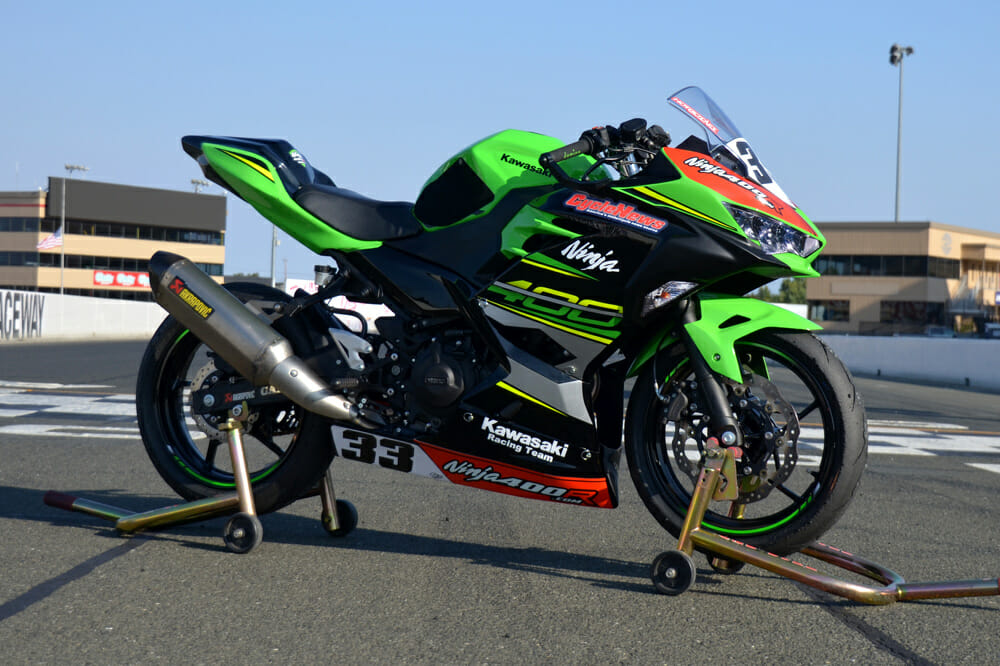
Let’s Race!
If you’ve ever read one of my tests or seen a video on YouTube, you’ll know how much I love riding little bikes. Unlike a superbike that feels at times like you’re going into a heavyweight title fight, a junior cup-level motorcycle can feel like your friend, always making you push a little harder without quite the consequences if it goes bad thanks to the reduced speeds, braking and acceleration forces.
Toye’s racer feels exactly like a proper little bike should: stiff, responsive and very, very light. The man claims a 310-pounds wet weight for the expert club-spec machine and with 56 horsepower on tap, it makes for a potent weapon.
I hadn’t raced on the tarmac since this year’s Pikes Peak International Hill Climb on my KTM 1290 Super Duke R—a bike very, very different from this—so it took a bit of time to blow the cobwebs off at one of my favorite of all tracks, Sonoma.
 Charging through the pack against the bigger 450 Superbike machines was a laugh.
Charging through the pack against the bigger 450 Superbike machines was a laugh.
Luckily, I had an advantage as Toye had spent Friday setting the 400 up for me, and as he’s far better at that than me, I knew the bike was going to be spot on.
The weekend started great. Pole position on Saturday in Formula III with a 1:50.206 was a good way to get going, although I had to start from the back of the fourth row for the Lightweight Twins and even further back for the beginning of the 450 Superbike race as I didn’t have any points in the 2018 series.
I managed to take the win in Lightweight Twins against Marc Edwards, going third overall against the 700 Superstock and Formula Singles (basically MotoAmerica Twins Cup bikes), and took another win later in the day, this time in the Formula III event.
But, the most fun race of the day wasn’t actually one in which I got the win. The 450 Superbike race was hectic, and as I had the slowest bike against 600 Supersport bikes that had one cylinder killed (thus making them essentially a 450 triple), it was a bit like fighting with one arm tied behind my back. And because I was starting so far back, I had plenty of guys to pass.
What. Awesome. Fun.
There’s hardly a better feeling than railing around the outside of bikes much larger and faster on a little 400. I passed everyone except one, coming up just short on the drag to the line. No matter, I was laughing my ass off the whole race.
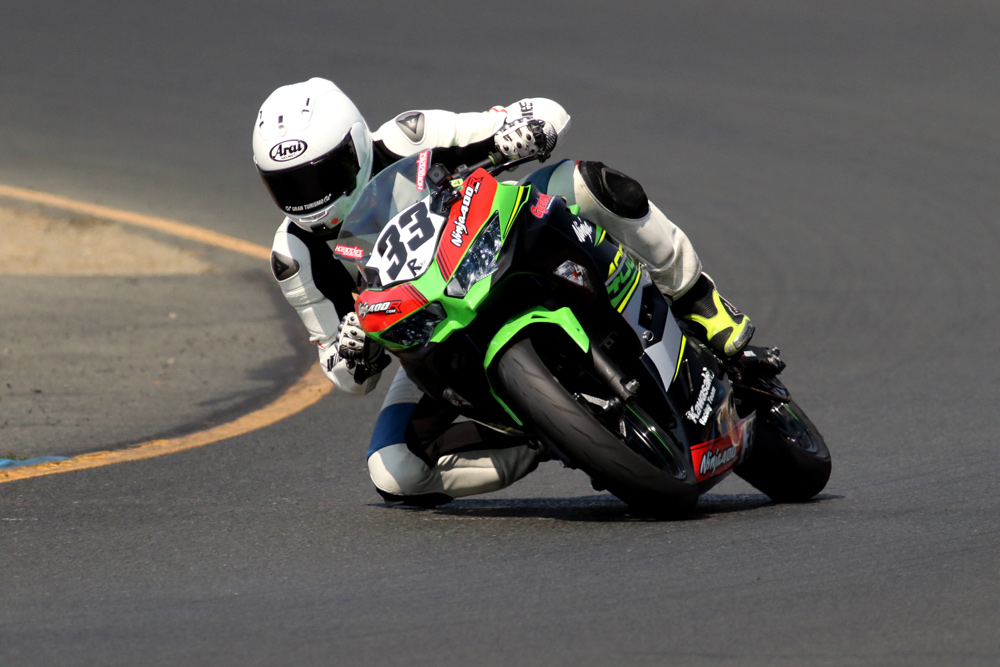 Toye’s bike was so well set up and such a joy to race.
Toye’s bike was so well set up and such a joy to race.
Toye’s toy whizzed me around Sonoma to a best lap of 1:49.407, which would have put me right in the mix in the MotoAmerica Junior Cup had I been a 16-year-old racing against Yates and Co. (notwithstanding the higher rpms and less weight my bike had). I hadn’t had that much fun racing in years—it was the exact opposite of the stress-inducing Pikes Peak race this year.
Toye’s Ninja400r.com racer the kind of bike everyone should have a go on. Even 2018 MotoAmerica Stock 1000 Champion Andrew Lee popped his head in and said he was desperate to have a go.
The combination of a good base bike with light weight, enough horsepower, excellent tires in the Pirelli Supercorsas, and in good company made for an awesome weekend at the track. And taking home a few bucks prize money and a couple of trophies made it even better. CN